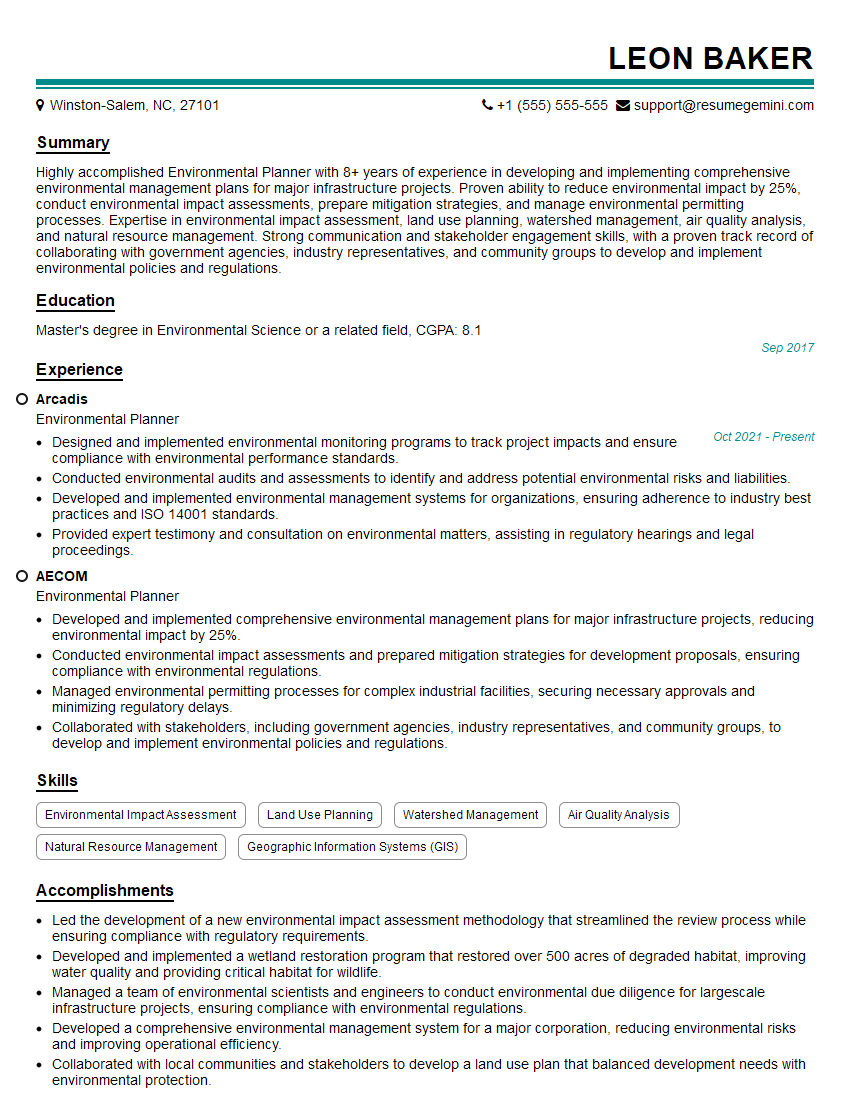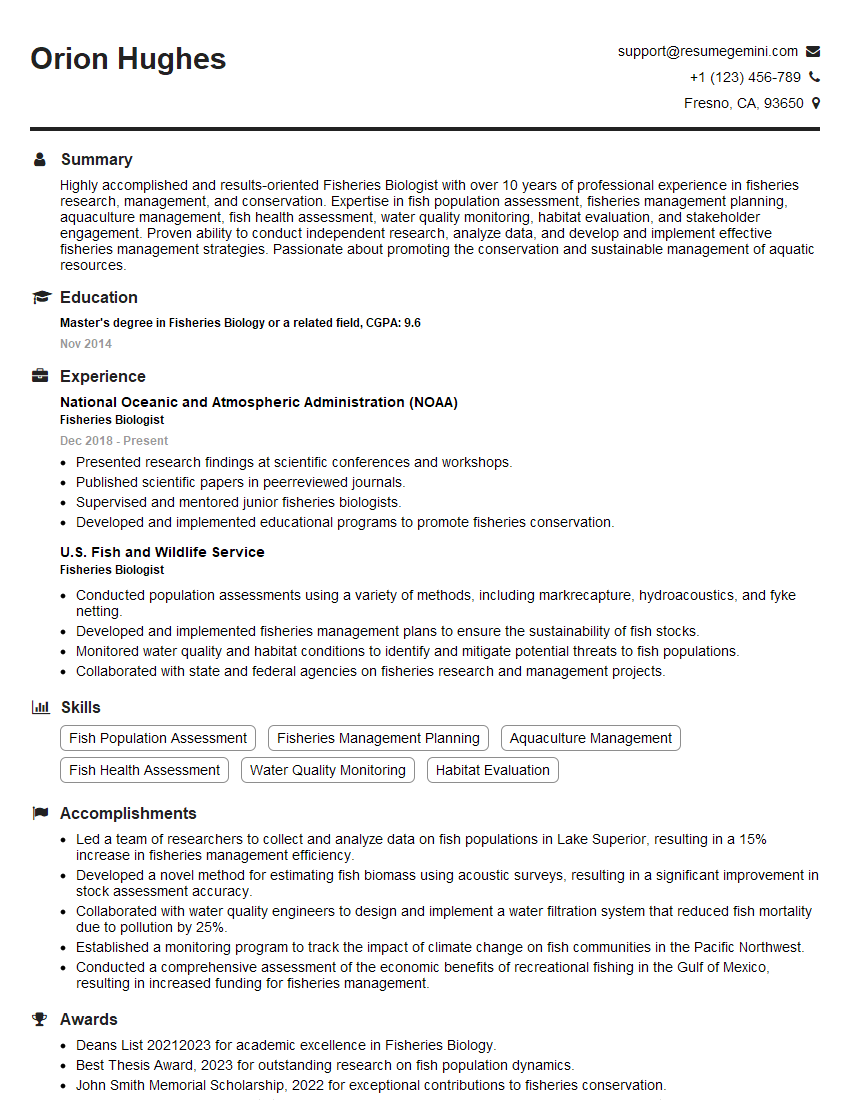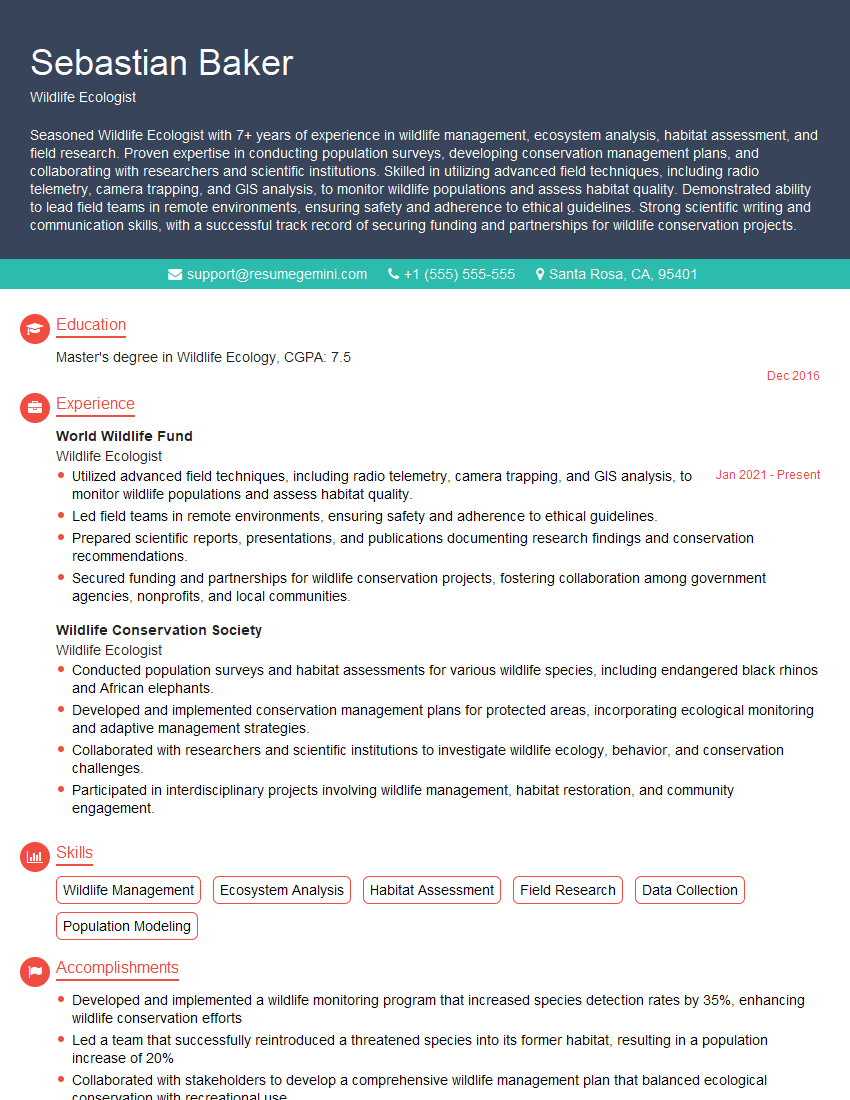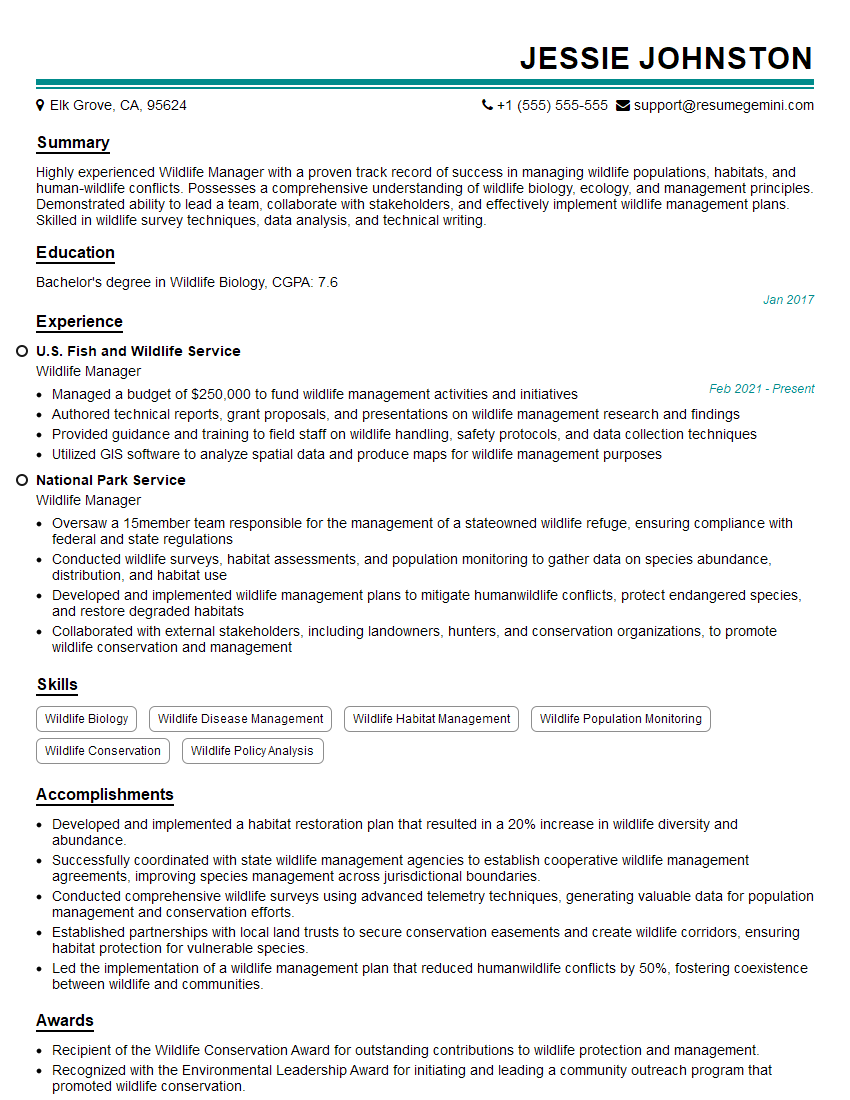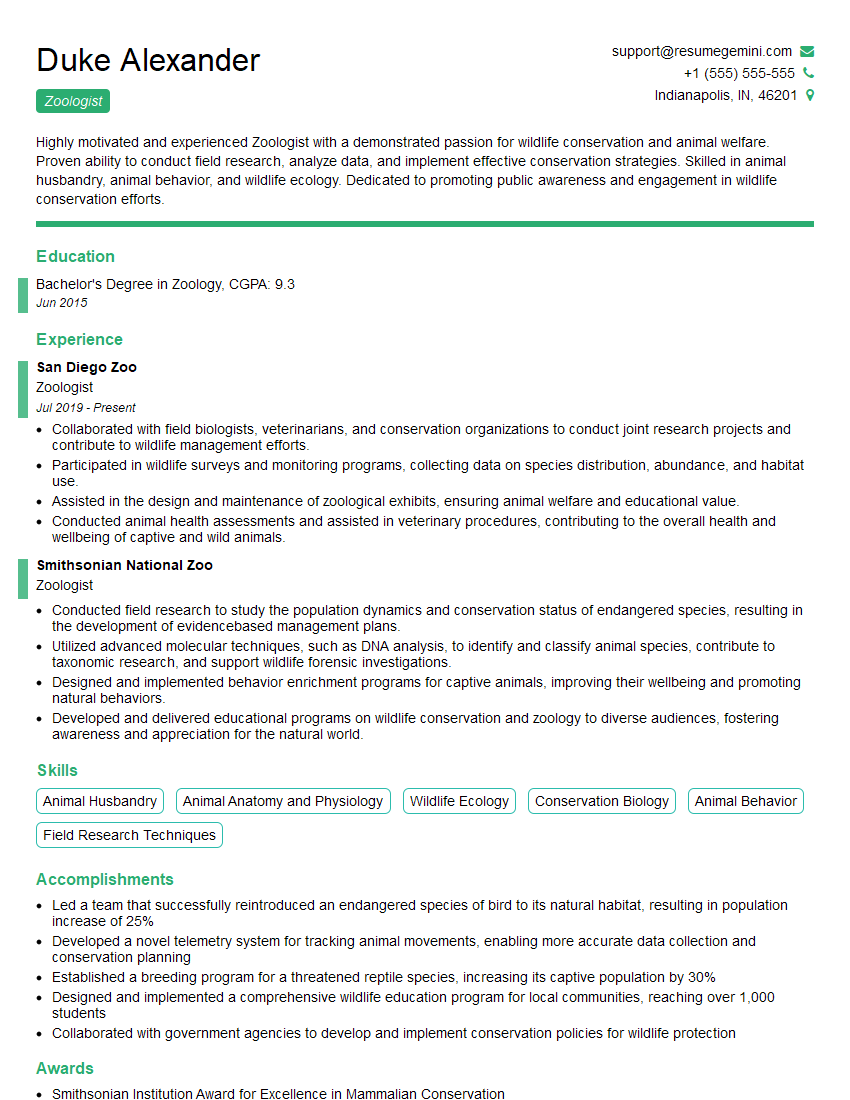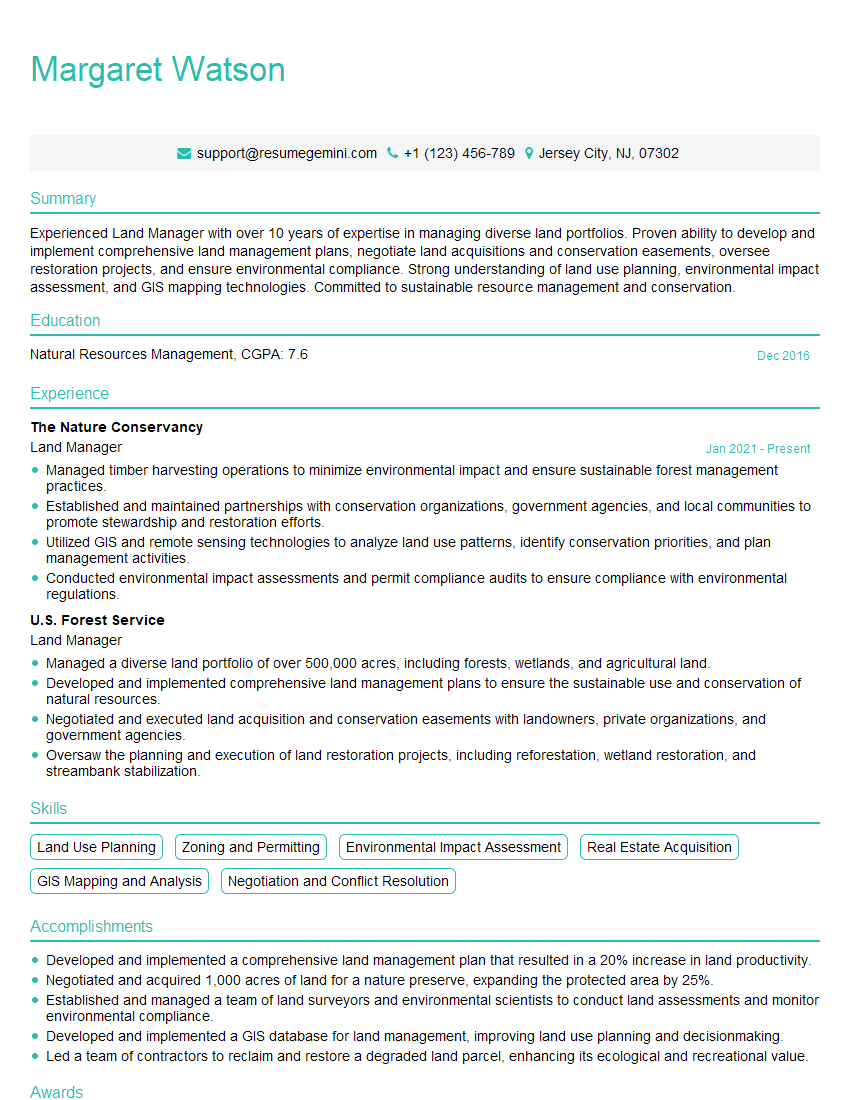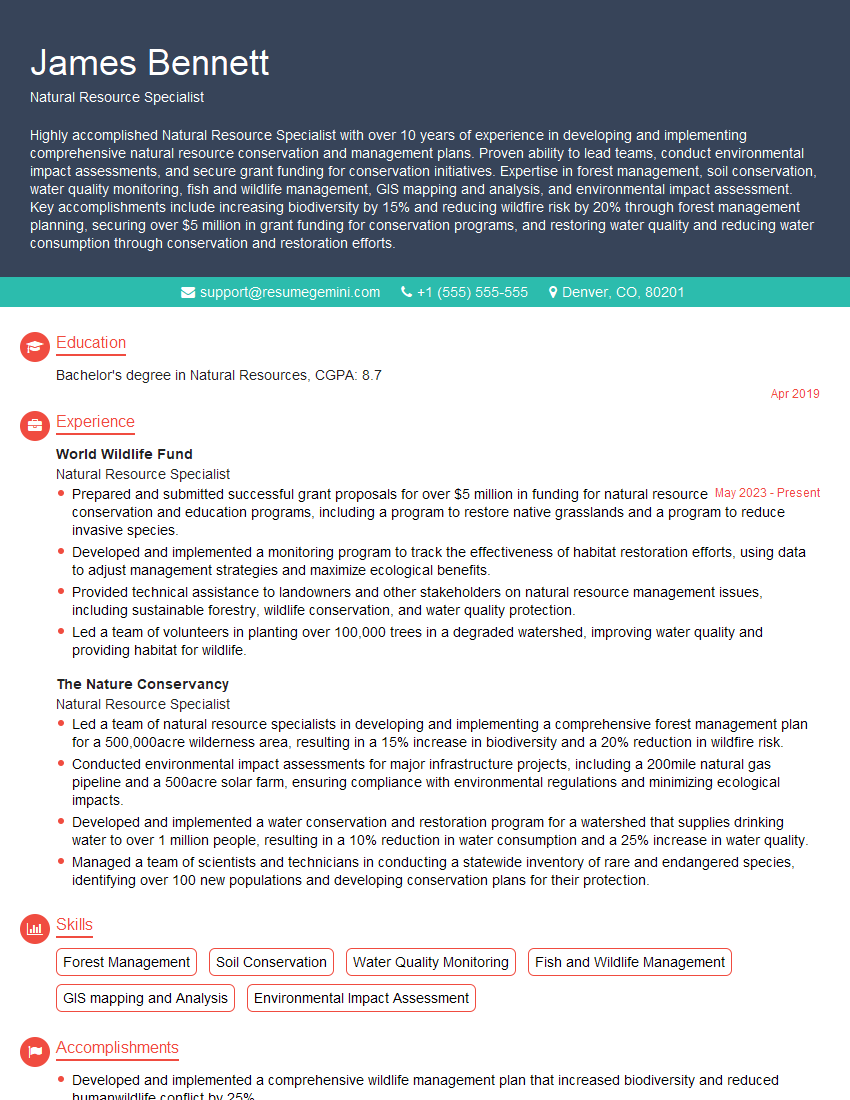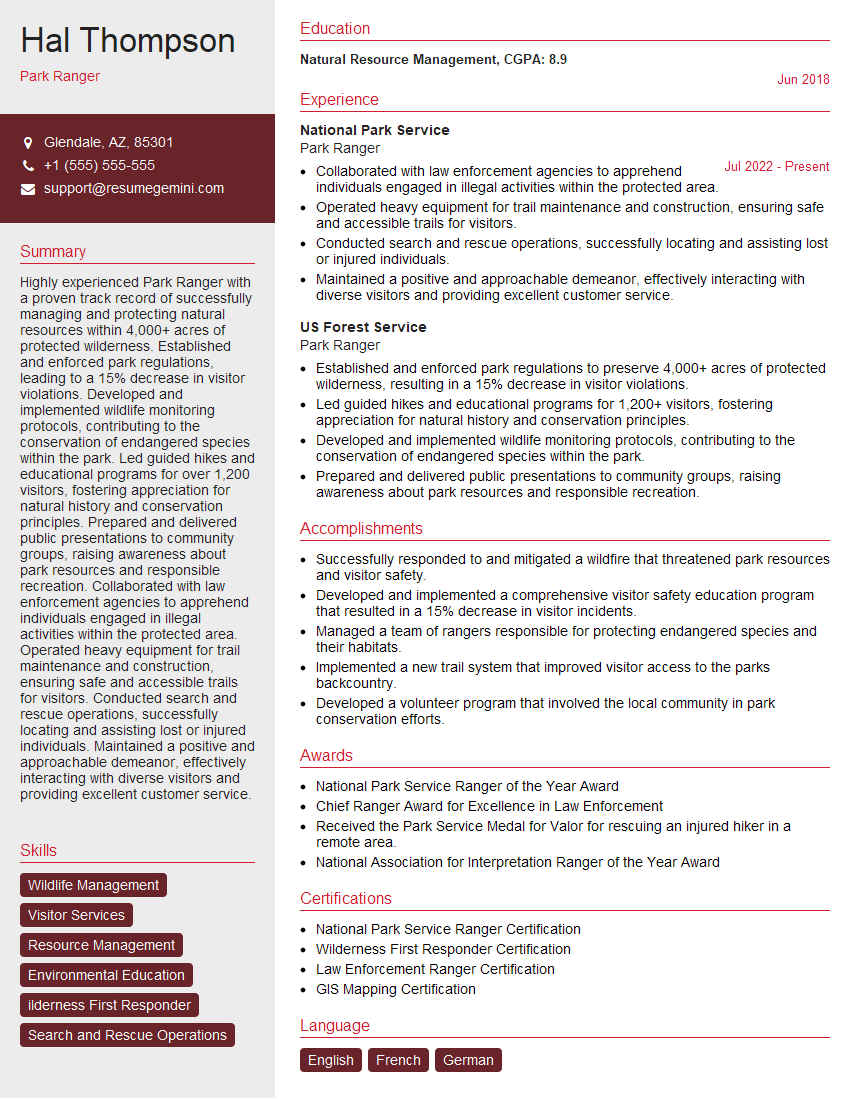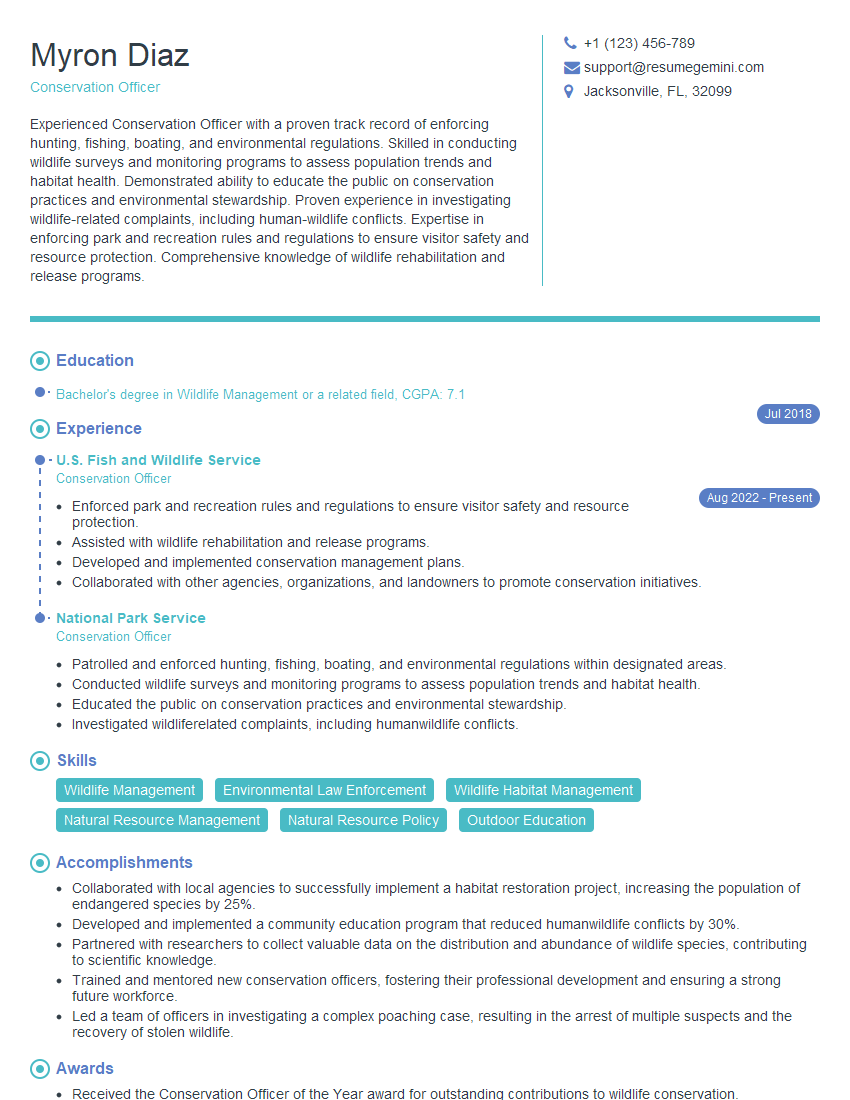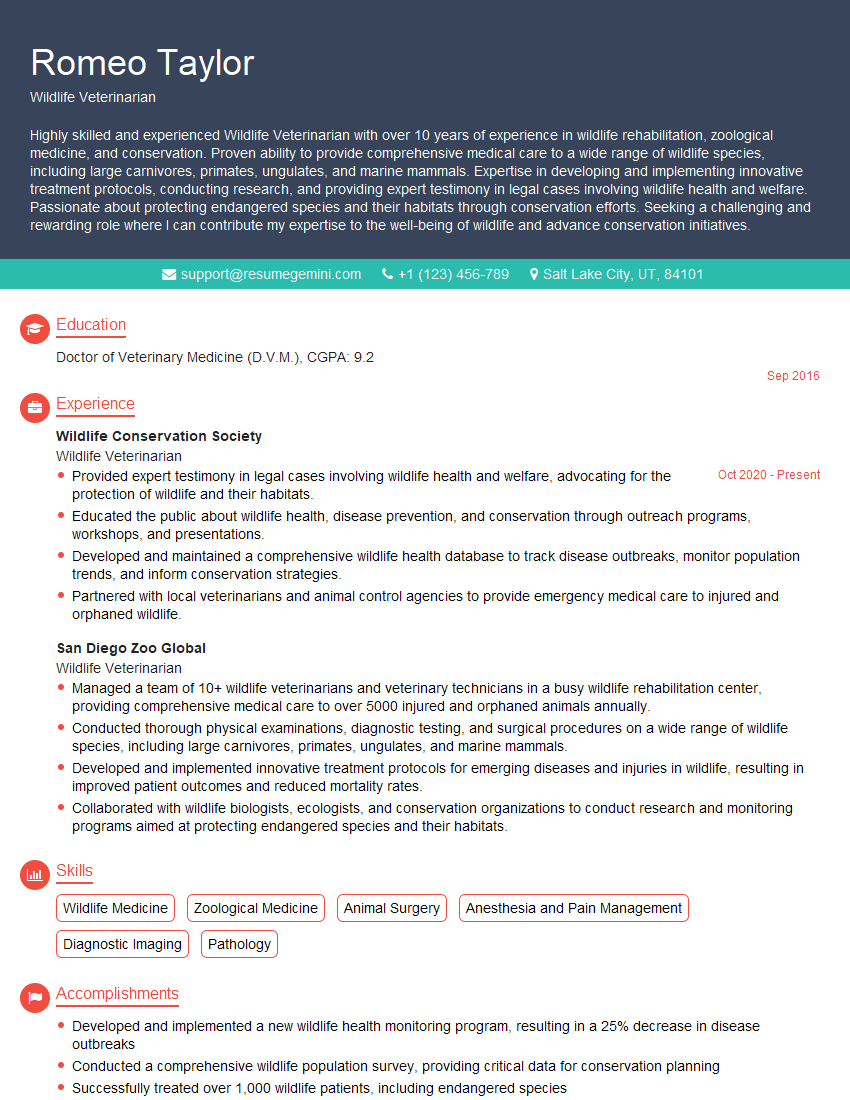Interviews are more than just a Q&A session—they’re a chance to prove your worth. This blog dives into essential Ethics and Professionalism in Wildlife Management interview questions and expert tips to help you align your answers with what hiring managers are looking for. Start preparing to shine!
Questions Asked in Ethics and Professionalism in Wildlife Management Interview
Q 1. Describe the ethical considerations involved in habitat restoration projects.
Ethical considerations in habitat restoration are multifaceted, focusing on ecological integrity, social justice, and economic sustainability. We must consider the potential impacts on all species, not just the target species we’re aiming to help. For example, restoring a wetland might inadvertently displace a nesting bird species if the restoration isn’t carefully planned.
- Prioritizing native species: Using only native plants and animals avoids introducing invasive species that could outcompete native flora and fauna.
- Minimizing disruption to existing ecosystems: Restoration projects should be designed to minimize disturbance to surrounding areas and existing communities. This could involve careful site selection, phased implementation, and the use of ecologically sound techniques.
- Considering the social and economic impacts: Engaging local communities in the planning and implementation phases is crucial. This helps ensure that the project aligns with their needs and avoids displacing people or limiting their access to resources.
- Transparency and accountability: Open communication with stakeholders throughout the project lifecycle ensures accountability and fosters trust.
For example, a project aiming to restore a degraded forest might need to consider the impact on local communities who rely on the forest for resources like timber or non-timber forest products. A participatory approach involving the community in decision-making and benefit-sharing can ensure the project’s ethical success.
Q 2. Explain how you would handle a conflict between stakeholder interests in wildlife management.
Handling stakeholder conflicts in wildlife management requires a collaborative and transparent approach. Imagine a scenario where a proposed nature reserve impacts local farmers’ land.
- Identify all stakeholders: This includes local communities, landowners, government agencies, conservation organizations, and potentially businesses impacted.
- Facilitate open communication: Create a forum for stakeholders to express their concerns, needs, and perspectives. Active listening is paramount.
- Identify common ground: Focus on shared goals and values. Often, despite initial disagreements, stakeholders share a common desire for environmental sustainability and community well-being.
- Negotiate and compromise: Explore alternative solutions that address the concerns of different stakeholders. This might involve creating buffer zones, offering compensation, or adjusting the reserve boundaries.
- Document agreements: Any decisions reached should be clearly documented and legally binding to ensure accountability.
- Monitor and evaluate: Regularly assess the effectiveness of the implemented solutions and make adjustments as needed.
Mediation or arbitration might be necessary in cases where negotiation fails to resolve conflicts. The key is to find solutions that are both ecologically sound and socially just.
Q 3. How do you ensure the humane treatment of animals during research or management activities?
Humane treatment of animals in research and management is paramount, guided by the “3Rs”: Replacement, Reduction, and Refinement.
- Replacement: Whenever possible, researchers should explore alternatives to using animals, such as using computer models or cell cultures.
- Reduction: Minimize the number of animals used in research or management actions. Careful experimental design and statistical analysis are key to reducing sample sizes.
- Refinement: Minimize pain, distress, and suffering during the study. This involves appropriate anesthesia, analgesia, and post-operative care.
All procedures must be reviewed and approved by an Institutional Animal Care and Use Committee (IACUC) to ensure they adhere to high ethical standards. For example, capturing animals for research should only be done using methods that minimize stress and injury. Appropriate handling techniques, quick processing, and prompt release or euthanasia (if necessary and approved) are essential.
Q 4. What is your understanding of the role of professional codes of conduct in wildlife management?
Professional codes of conduct in wildlife management act as ethical guidelines and provide a framework for responsible practices. They ensure that wildlife professionals act with integrity, accountability, and respect for wildlife and ecosystems.
- Maintaining high ethical standards: Codes of conduct outline the expected behavior of wildlife professionals, promoting objectivity, honesty, and transparency in their work.
- Protecting wildlife: They emphasize the importance of conservation and the protection of wildlife from harm and exploitation.
- Ensuring public trust: By adhering to ethical guidelines, wildlife professionals build public trust and support for their work.
- Promoting professionalism: Codes of conduct contribute to professional development and the maintenance of a high standard of practice within the wildlife management profession.
Examples include codes developed by professional organizations such as The Wildlife Society. Adherence to these codes is crucial for maintaining credibility and public trust within the profession.
Q 5. Discuss the ethical implications of using lethal control methods for wildlife populations.
Lethal control methods, like culling or hunting, raise significant ethical concerns. While sometimes necessary for population management or disease control, they must be implemented judiciously and with careful consideration.
- Justifying the need: Lethal control must be the last resort, only employed when non-lethal methods have proven insufficient. A strong scientific justification is necessary, demonstrating a clear and immediate threat to public safety, biodiversity, or ecosystem health.
- Minimizing suffering: Methods used must minimize pain and distress. This involves using appropriate tools and techniques.
- Transparency and accountability: The entire process, from decision-making to implementation and post-control monitoring, must be transparent and accountable to the public.
- Addressing potential unintended consequences: Careful assessment of potential impacts on non-target species and ecosystem dynamics is crucial.
For example, culling deer to prevent overgrazing in a sensitive ecosystem needs justification based on scientific data demonstrating the negative impacts of overgrazing and the failure of non-lethal control measures. The method of culling must also be chosen to minimize animal suffering.
Q 6. How would you address a situation where a colleague is not adhering to ethical guidelines?
Addressing unethical behavior by a colleague requires a cautious yet firm approach. It’s crucial to prioritize both the well-being of the colleague and the integrity of the profession.
- Gather evidence: Document the specific instances of unethical behavior with concrete evidence.
- Private conversation: Start with a private conversation with the colleague, expressing your concerns in a constructive and supportive manner. Focus on the behavior, not the person.
- Report to appropriate authorities: If the behavior continues or if the initial conversation is unproductive, report the issue to the relevant authorities, such as a supervisor or professional organization.
- Follow organizational policies and procedures: Adhere to the organization’s established protocols for handling ethical violations.
Remember to maintain confidentiality while upholding ethical standards. It’s a balance between supporting a colleague and upholding professional ethics. If the unethical behavior involves illegal activities, reporting to the relevant authorities is mandatory.
Q 7. Describe your approach to conflict resolution when dealing with violations of wildlife laws.
Conflict resolution in cases of wildlife law violations involves a multi-step process emphasizing fairness, due process, and ecological protection.
- Gather evidence: Thoroughly investigate the alleged violation, collecting all necessary evidence, such as witness statements, photographs, and documentation.
- Follow legal procedures: Adhere to established legal procedures and regulations, ensuring all actions are within the bounds of the law.
- Mediation: In some cases, mediation may be appropriate to facilitate a resolution that addresses both the legal and ecological aspects of the violation. This could involve restorative justice approaches.
- Legal action: If mediation fails, or if the violation is serious, pursuing legal action according to established procedures is necessary. This might include issuing warnings, fines, or other penalties.
- Enforcement and rehabilitation: Enforcement must be fair and consistent. It could include rehabilitation programs for those who have committed violations.
The goal is not simply to punish the offender but to deter future violations and promote compliance with wildlife laws, fostering a culture of respect for wildlife and ecosystems.
Q 8. Explain how you would balance the needs of wildlife conservation with human development needs.
Balancing wildlife conservation and human development requires a nuanced approach that prioritizes sustainable solutions. It’s not about choosing one over the other, but finding creative ways to coexist. Think of it like a carefully crafted ecosystem – where both wildlife and humans thrive.
Strategic Spatial Planning: Identifying areas crucial for wildlife habitat and designating them as protected zones, while simultaneously developing human infrastructure in areas with less ecological sensitivity. For example, building towns outside of crucial migration corridors or nesting grounds.
Community Engagement: Involving local communities in conservation efforts ensures buy-in and reduces conflict. This might involve providing alternative livelihood options that are less reliant on exploiting wildlife resources, such as ecotourism or sustainable agriculture.
Mitigation Measures: Implementing measures to minimize the impact of human development on wildlife. This could include wildlife crossings under highways or building noise barriers near sensitive breeding areas.
Environmental Impact Assessments (EIAs): Conducting thorough EIAs before any major development projects to assess potential impacts on wildlife and ecosystems, and incorporating mitigation strategies into the project design.
For instance, the creation of wildlife corridors in fragmented landscapes allows animals to move safely between protected areas, even in areas with human development.
Q 9. What strategies would you employ to promote ethical behavior among your team members?
Promoting ethical behavior requires a multi-pronged strategy that focuses on education, leadership, and accountability. It’s about fostering a culture of responsibility where everyone understands and upholds the highest ethical standards.
Code of Conduct: Establishing and regularly reviewing a clear code of conduct specific to wildlife management, outlining expected ethical behavior and professional standards. This should include clear consequences for unethical actions.
Training and Education: Providing comprehensive training on ethical wildlife management practices, including relevant laws, regulations, and best practices. This should be ongoing and incorporate case studies and ethical dilemmas.
Mentorship and Role Modeling: Encouraging experienced professionals to mentor junior staff, providing guidance and setting a positive example of ethical conduct. Lead by example.
Whistleblower Protection: Creating a safe and supportive environment where team members feel comfortable reporting unethical behavior without fear of retribution.
Regular Audits and Reviews: Implementing regular internal audits to assess compliance with ethical guidelines and professional standards.
For example, we might use role-playing scenarios to help team members navigate challenging ethical dilemmas they might face in the field.
Q 10. How do you ensure transparency and accountability in wildlife management decision-making?
Transparency and accountability are crucial for building public trust and ensuring ethical wildlife management. It’s about being open, honest, and responsible in all decision-making processes.
Public Access to Information: Making relevant information easily accessible to the public, including data on wildlife populations, management plans, and research findings.
Open Decision-Making Processes: Involving stakeholders – including the public, local communities, and other relevant organizations – in the decision-making process, ensuring their input is considered.
Clear and Accessible Reporting: Providing regular, transparent reports on wildlife management activities, including successes, challenges, and lessons learned. These reports should use plain language, avoiding technical jargon.
Independent Audits and Reviews: Subjecting management practices to independent audits and reviews to ensure accountability and identify areas for improvement.
Mechanism for Feedback and Complaints: Establishing clear channels for the public to provide feedback and lodge complaints about wildlife management practices.
For instance, publishing population data online with explanations of management strategies ensures transparency.
Q 11. Discuss the ethical implications of using technology (e.g., drones, GPS tracking) in wildlife management.
Technology offers incredible opportunities in wildlife management, but it also raises ethical considerations that need careful consideration. We must balance the benefits with the potential risks to wildlife and their habitats.
Privacy Concerns: The use of drones and GPS tracking raises concerns about the privacy of wildlife, potentially disrupting their natural behavior. We must ensure that these technologies are used responsibly and minimize disturbance.
Data Security and Ownership: Protecting the security and integrity of collected data is essential. We need to consider who owns the data and how it will be used and shared, ensuring compliance with data protection regulations.
Potential for Misuse: These technologies could be misused for poaching, illegal wildlife trade, or other harmful activities. Robust security measures and strict regulations are crucial.
Environmental Impact: The use of drones, for example, can impact wildlife through noise and visual disturbance. Environmental impact assessments should be done before widespread deployment.
Bias in Algorithms: Algorithms used to analyze data from these technologies can be biased, leading to inaccurate or unfair conclusions. We need to be aware of and mitigate potential biases.
For example, using drones to monitor nesting sites requires careful planning to minimize disturbance and adhere to ethical guidelines on wildlife observation.
Q 12. How do you integrate scientific evidence into ethical wildlife management decisions?
Integrating scientific evidence into ethical wildlife management decisions is paramount. It ensures that our actions are based on sound data and a thorough understanding of ecological processes.
Evidence-Based Decision-Making: Using the best available scientific evidence to inform all management decisions, prioritizing evidence-based approaches over subjective opinions or biases.
Peer Review and Validation: Ensuring that scientific findings are subject to rigorous peer review before being used to inform management decisions. This adds an extra layer of scrutiny and validation.
Adaptive Management: Implementing management plans that are adaptive and responsive to new scientific findings and monitoring data. This iterative process allows for ongoing refinement and improvement.
Transparency in Data Use: Clearly documenting the scientific evidence used to inform management decisions, making this data transparent and accessible to the public.
Interdisciplinary Approach: Engaging experts from various scientific disciplines – ecology, genetics, veterinary science, etc. – to provide a comprehensive understanding of the issue.
For example, data on population declines of a certain species would drive conservation efforts, potentially leading to protected areas or breeding programs.
Q 13. How would you respond to public criticism of wildlife management practices?
Responding to public criticism requires professionalism, transparency, and a willingness to engage in constructive dialogue. It is an opportunity to demonstrate accountability and build trust.
Acknowledge and Validate Concerns: Acknowledge the public’s concerns and validate their right to express their views. Even if you disagree with the criticism, show respect for their perspective.
Provide Clear and Concise Explanations: Provide clear, evidence-based explanations of the wildlife management practices in question, using simple language and avoiding jargon.
Engage in Open Dialogue: Engage in open dialogue with the public, inviting questions and feedback. Be prepared to answer tough questions honestly and respectfully.
Transparency in Decision-Making: Demonstrate the transparency of the decision-making process, outlining the scientific evidence and stakeholder input used to inform the decisions.
Consider Feedback and Adapt: Consider the feedback received and be willing to adapt management practices based on legitimate concerns. This demonstrates responsiveness and a commitment to improvement.
For example, a public forum or online Q&A session could help address concerns and foster better communication.
Q 14. How do you ensure fairness and equity in the distribution of wildlife resources?
Fair and equitable distribution of wildlife resources is crucial for social justice and the long-term sustainability of wildlife populations. It’s about ensuring that the benefits of wildlife are shared fairly among all stakeholders.
Community-Based Natural Resource Management (CBNRM): Empowering local communities to manage wildlife resources, ensuring that they benefit directly from conservation efforts.
Equitable Access to Resources: Ensuring equitable access to wildlife resources, avoiding situations where certain groups or individuals are disproportionately advantaged or disadvantaged.
Benefit Sharing Mechanisms: Developing benefit-sharing mechanisms to ensure that the benefits of wildlife resources are fairly distributed among local communities, governments, and other stakeholders.
Addressing Historical Injustices: Addressing any historical injustices that have led to unequal access to wildlife resources, such as displacement or marginalization of indigenous communities.
Participatory Decision-Making: Involving all stakeholders – including local communities, government agencies, and non-governmental organizations – in decision-making processes related to wildlife resources.
For example, co-management agreements with local communities can ensure they receive a portion of revenue generated from ecotourism in their area.
Q 15. What are some common ethical dilemmas faced in wildlife rehabilitation?
Ethical dilemmas in wildlife rehabilitation are frequent and complex, often stemming from the conflict between the animal’s best interests and practical limitations. A key challenge is deciding when to intervene and when to let nature take its course. For example, should we aggressively treat a severely injured bird with a low chance of survival, potentially diverting resources from animals with a higher chance of successful rehabilitation? Another common dilemma involves the release process. Is releasing an animal back into the wild always the best option, or might it be more ethical to place it in a protected sanctuary if its chances of survival in the wild are low due to habitat loss or other factors? We also face difficulties in determining when an animal is truly “rehabilitated” and ready for release; premature release can lead to failure and death while keeping an animal too long can lead to habituation and an inability to survive in the wild. Finally, ethical considerations extend to the availability and allocation of resources. Limited funding and staff can force difficult decisions about which animals receive treatment.
Career Expert Tips:
- Ace those interviews! Prepare effectively by reviewing the Top 50 Most Common Interview Questions on ResumeGemini.
- Navigate your job search with confidence! Explore a wide range of Career Tips on ResumeGemini. Learn about common challenges and recommendations to overcome them.
- Craft the perfect resume! Master the Art of Resume Writing with ResumeGemini’s guide. Showcase your unique qualifications and achievements effectively.
- Don’t miss out on holiday savings! Build your dream resume with ResumeGemini’s ATS optimized templates.
Q 16. How would you handle a situation involving poaching or illegal wildlife trade?
Handling poaching or illegal wildlife trade requires a multi-pronged approach prioritizing safety and legality. First, I would immediately report the incident to the relevant authorities – local law enforcement, wildlife agencies, and potentially Interpol for international trafficking cases. This is paramount to ensure the safety of myself and any others involved, as well as to facilitate the successful investigation and prosecution. Gathering evidence without jeopardizing my own safety is crucial. This might involve documenting the scene (photos, videos), recording witness statements, and noting any distinguishing features of the poachers or their equipment. It’s important to avoid direct confrontation, as safety is the top priority. Once legal authorities are involved, collaboration becomes essential. I might be called upon to assist in the investigation by providing expert knowledge about the affected species, their habitat, and the potential impacts of the crime. Long-term, contributing to community education and awareness programs to prevent future poaching and trafficking is a vital preventative measure. This might involve working with local communities to find alternative sources of income and empowering them to become active protectors of their wildlife.
Q 17. Describe your approach to managing wildlife conflicts with agriculture.
Managing wildlife conflicts with agriculture requires a balanced approach that considers the needs of both farmers and wildlife. My approach would involve a combination of strategies, starting with assessing the specific nature of the conflict. This involves identifying the species involved, the agricultural practices affected, and the severity of the damage. For example, if the conflict involves elephants raiding crops, we might employ a combination of strategies including:
- Habitat restoration and improvement: Creating wildlife corridors and improving habitat outside of agricultural areas to reduce the animals’ dependence on farmland.
- Non-lethal deterrents: Implementing methods such as electric fences, noise deterrents, and guard dogs to discourage wildlife from entering agricultural lands.
- Crop protection techniques: Introducing strategies like using alternative crops or implementing protective measures around fields.
- Compensation schemes: Providing farmers with financial compensation for losses incurred due to wildlife damage.
- Community engagement: Educating farmers and communities about coexistence strategies and the importance of biodiversity.
Q 18. Explain your understanding of the precautionary principle in wildlife conservation.
The precautionary principle in wildlife conservation states that when there is a threat of significant harm to the environment or wildlife, even if the scientific evidence is incomplete, we should take preventative action. It’s essentially a risk-averse approach. Instead of waiting for definitive proof of harm, the principle emphasizes proactive measures to protect biodiversity. For instance, if a new pesticide is proposed for use near a sensitive wildlife habitat, even without conclusive evidence of harm to the local ecosystem, the precautionary principle suggests proceeding cautiously, perhaps by conducting extensive risk assessments, implementing strict monitoring protocols, or even opting for a safer alternative. This principle is vital because the consequences of irreversible damage to wildlife populations or habitats can far outweigh the costs of preventive measures. It promotes a proactive, responsible approach to conservation, recognizing the inherent uncertainties and potential irreversible impacts within ecological systems.
Q 19. How would you manage conflicting scientific data when making management decisions?
Managing conflicting scientific data when making management decisions is a common challenge. My approach involves a systematic process:
- Comprehensive review: I would thoroughly review all available scientific data, including methodologies, sample sizes, and potential biases. This might involve seeking input from multiple experts in different fields.
- Identify inconsistencies: Clearly identifying the points of disagreement and potential reasons for discrepancies is crucial. Are the studies using different methodologies? Are the geographic locations or timeframes different? Are there any inherent biases in the data?
- Synthesize findings: I would attempt to synthesize the findings by identifying common threads, areas of agreement, and weighing the evidence based on the quality and robustness of each study. This step often requires critical thinking skills and a clear understanding of statistical analysis.
- Consult with experts: Seeking advice from other leading scientists in the field allows for a more informed and objective decision. Peer-review and independent analysis can be invaluable in resolving discrepancies.
- Transparency and adaptive management: It’s vital to document the decision-making process thoroughly and transparently. Recognizing that data are continuously evolving, adaptive management should be implemented, using further data collection to test assumptions and refine management strategies.
Q 20. How do you ensure the long-term sustainability of wildlife populations?
Ensuring the long-term sustainability of wildlife populations requires a holistic approach encompassing several key areas:
- Habitat protection and restoration: Protecting and restoring crucial habitats is paramount. This includes establishing protected areas, combating deforestation and habitat fragmentation, and mitigating climate change impacts.
- Population monitoring and assessment: Regular monitoring of wildlife populations allows for early detection of declines, and helps in understanding population dynamics and identifying threats.
- Combating poaching and illegal wildlife trade: Effective law enforcement and community-based anti-poaching strategies are vital in reducing illegal activities that threaten wildlife.
- Disease management: Monitoring and managing wildlife diseases can help prevent widespread outbreaks that can decimate populations.
- Sustainable resource management: Managing natural resources sustainably, including water and vegetation, ensures the long-term health of ecosystems.
- Climate change mitigation and adaptation: Addressing climate change is vital for biodiversity conservation, as it affects habitats, species distributions, and ecosystem stability.
- Collaborative conservation: Bringing together stakeholders – governments, NGOs, local communities, and researchers – is essential for comprehensive and effective conservation efforts.
Q 21. What is your understanding of the importance of community engagement in wildlife management?
Community engagement is crucial for successful wildlife management because local communities are often the most intimately connected to wildlife and their habitats. Their knowledge, perspectives, and participation are essential for effective and sustainable conservation. My approach involves:
- Participatory planning: Involving communities in the planning process ensures that management decisions reflect their needs and concerns and that strategies are culturally appropriate.
- Capacity building: Equipping local communities with the skills and resources to participate in conservation initiatives empowers them to become active stakeholders.
- Benefit-sharing: Ensuring that communities benefit directly from conservation efforts promotes their long-term commitment to wildlife protection. This might include eco-tourism initiatives, sustainable harvesting programs, or job creation related to conservation.
- Conflict resolution: Addressing conflicts between human activities and wildlife needs requires open communication, collaboration, and finding solutions that are acceptable to all parties.
- Traditional ecological knowledge: Recognizing and incorporating traditional knowledge and practices of local communities enhances conservation strategies.
Q 22. How do you navigate the challenges of working in diverse teams in wildlife management?
Working effectively in diverse teams is paramount in wildlife management, where expertise spans biology, sociology, policy, and more. My approach centers on fostering respectful communication and valuing diverse perspectives. I actively listen to understand different viewpoints, even those that challenge my own.
- Respectful Dialogue: I initiate and participate in open discussions, ensuring everyone feels heard and valued. This involves creating a safe space where differing opinions can be expressed without fear of judgment.
- Collaborative Problem-Solving: I believe in leveraging the unique strengths of each team member. By identifying individual expertise and assigning tasks accordingly, we can approach challenges more efficiently and comprehensively. For instance, in a project involving a threatened bird population, the biologist might focus on habitat analysis, while a sociologist examines the community’s interaction with the birds.
- Conflict Resolution: Disagreements are inevitable in any team. I address conflicts promptly and constructively, focusing on the issue at hand rather than personalities. My approach emphasizes finding common ground and solutions that benefit the project and the team’s long-term collaboration.
For example, during a recent habitat restoration project, our team included ecologists, landowners, and local community members. By facilitating open communication and valuing each perspective, we reached a consensus that ensured both ecological integrity and community buy-in, leading to a successful project.
Q 23. Describe your experience with using data-driven decision making in wildlife management.
Data-driven decision making is crucial for responsible and effective wildlife management. It moves beyond anecdotal evidence and relies on rigorous analysis to guide conservation strategies.
My experience involves using various datasets, such as population surveys, habitat mapping, and climate change projections, to inform management actions. I’m proficient in using statistical software (e.g., R, ArcGIS) to analyze this data and generate actionable insights.
For instance, in a study on the impact of habitat fragmentation on a specific mammal species, I used GIS to model habitat connectivity and population viability under different scenarios. This data showed that establishing wildlife corridors would significantly improve the population’s long-term survival. This analysis directly informed the design of our conservation plan.
Furthermore, I use monitoring data to evaluate the effectiveness of our interventions. By regularly assessing the impact of implemented strategies, we can adapt our approaches for optimal results, ensuring accountability and improving our conservation efforts over time.
Q 24. How do you communicate complex scientific information to non-scientists effectively?
Communicating complex scientific information to non-scientists requires clear, concise, and engaging language. It’s about translating technical jargon into easily understood concepts.
- Plain Language: I avoid using technical terms whenever possible, and if necessary, I define them clearly in simple terms.
- Visual Aids: I utilize graphs, charts, and images to illustrate key findings and make the information more accessible. A picture is often worth a thousand words, especially when conveying complex ecological relationships.
- Storytelling: Weaving scientific findings into compelling narratives can make information more relatable and memorable. I focus on the ‘why’ – the relevance and impact of the scientific findings on the audience’s lives or concerns.
- Interactive Engagement: Question-and-answer sessions and open forums allow me to address audience concerns directly and foster a better understanding of the topic.
For example, when presenting research on the decline of local pollinators to a community group, I used simple graphics showing the decline in bee populations alongside images of the crops these bees pollinated, highlighting the practical implications of pollinator loss for the community’s food security and economy.
Q 25. What is your approach to maintaining your professional development in wildlife management?
Maintaining professional development is crucial in a constantly evolving field like wildlife management. My approach is multifaceted:
- Continuing Education: I regularly attend workshops, conferences, and seminars to stay abreast of the latest research, techniques, and policy changes. I also actively participate in professional organizations to engage with colleagues and network.
- Mentorship and Collaboration: I actively seek mentorship from experienced professionals and collaborate with colleagues on research projects. These interactions provide valuable learning opportunities and foster professional growth.
- Independent Learning: I regularly read peer-reviewed journals, research reports, and other relevant literature to deepen my knowledge and expand my skillset.
- Technological Proficiency: I invest time in upgrading my skills in data analysis, GIS, and other relevant technologies that improve the efficiency and effectiveness of my work.
I believe continuous learning is not just a professional responsibility, but an essential component of ethical wildlife management, ensuring that I use the most current and effective approaches in my work.
Q 26. How would you handle a situation involving a media inquiry about a controversial wildlife management issue?
Handling media inquiries regarding controversial wildlife management issues requires careful consideration and a strategic approach. My approach involves:
- Accuracy and Transparency: I provide accurate and factual information, avoiding speculation or conjecture. I acknowledge uncertainties or gaps in knowledge openly and honestly.
- Contextualization: I place the issue within its broader scientific and social context, explaining the reasoning behind management decisions and the potential consequences of different courses of action.
- Balanced Presentation: I present multiple perspectives on the issue, acknowledging diverse viewpoints and concerns, while remaining clear about the scientific basis for our management actions.
- Collaboration with Communications Staff: I collaborate closely with communications professionals to ensure that information is presented clearly, effectively, and appropriately to the media and the public.
- Maintaining Professionalism: I remain calm, composed, and respectful even when faced with challenging questions or criticisms. My goal is to provide information that is helpful to the public and accurate in its representation of the situation.
For example, when a local newspaper questioned the culling of deer in an urban park, I worked with the communication team to explain the ecological rationale for population control, emphasizing the risk of overgrazing and the potential for disease transmission.
Q 27. Explain your understanding of adaptive management and its role in ethical wildlife conservation.
Adaptive management is a structured, iterative approach to wildlife conservation that emphasizes learning and flexibility. Instead of relying on static management plans, it uses monitoring data to evaluate the effectiveness of interventions and to adapt strategies over time. This is crucial for ethical conservation, as it allows us to minimize unintended consequences and maximize positive outcomes.
The process generally involves:
- Setting Objectives: Defining clear, measurable goals for the conservation efforts.
- Developing Strategies: Developing potential management strategies based on the best available scientific information.
- Implementation and Monitoring: Implementing the chosen strategies and collecting data to monitor their effectiveness.
- Analysis and Evaluation: Analyzing the collected data to assess the success of the interventions and identify any unintended consequences.
- Adaptation: Adapting the management strategies based on the evaluation results, incorporating new knowledge and insights to improve outcomes.
Ethical considerations are central to adaptive management. It promotes transparency, accountability, and continuous improvement, ensuring that we learn from our mistakes and continually refine our approaches to wildlife conservation. For example, if an initial strategy for reintroducing a species proves ineffective, adaptive management allows us to reassess the approach, gather additional data, and potentially implement different strategies, promoting both conservation success and responsible stewardship of natural resources.
Key Topics to Learn for Ethics and Professionalism in Wildlife Management Interview
- Wildlife Conservation Ethics: Understanding different ethical frameworks (e.g., utilitarian, deontological) and their application in decision-making regarding wildlife management practices.
- Stakeholder Engagement and Communication: Developing effective communication strategies to engage diverse stakeholders (landowners, communities, government agencies) in wildlife management initiatives, considering differing values and perspectives.
- Scientific Integrity and Data Transparency: Maintaining rigorous scientific standards in research and data collection, ensuring transparency and ethical handling of data in wildlife management projects.
- Professional Conduct and Codes of Ethics: Familiarizing yourself with professional codes of conduct within wildlife management organizations and adhering to the highest standards of integrity and accountability.
- Conflict Resolution and Negotiation: Developing skills in resolving conflicts that may arise between different stakeholders with competing interests in wildlife management. This includes understanding and applying conflict resolution frameworks.
- Environmental Justice and Equity: Recognizing and addressing potential biases and inequities in wildlife management practices, ensuring fair and equitable outcomes for all affected communities.
- Legal and Regulatory Frameworks: Understanding the legal and regulatory aspects of wildlife management, including relevant permits, licenses, and regulations at local, state, and federal levels.
- Sustainable Wildlife Management Practices: Applying principles of sustainability to wildlife management, considering the long-term ecological, social, and economic impacts of interventions.
- Case Studies in Ethical Dilemmas: Analyzing real-world case studies to develop critical thinking and problem-solving skills in ethically complex situations related to wildlife management.
Next Steps
Mastering Ethics and Professionalism in Wildlife Management is crucial for building a successful and impactful career. It demonstrates your commitment to responsible practices and positions you as a leader in the field. To increase your job prospects, create an ATS-friendly resume that highlights your skills and experience effectively. We highly recommend using ResumeGemini, a trusted resource for building professional resumes. ResumeGemini provides examples of resumes tailored specifically to Ethics and Professionalism in Wildlife Management to help you showcase your qualifications effectively. Take the next step towards your dream career – build a compelling resume today!
Explore more articles
Users Rating of Our Blogs
Share Your Experience
We value your feedback! Please rate our content and share your thoughts (optional).
What Readers Say About Our Blog
Hello,
We found issues with your domain’s email setup that may be sending your messages to spam or blocking them completely. InboxShield Mini shows you how to fix it in minutes — no tech skills required.
Scan your domain now for details: https://inboxshield-mini.com/
— Adam @ InboxShield Mini
Reply STOP to unsubscribe
Hi, are you owner of interviewgemini.com? What if I told you I could help you find extra time in your schedule, reconnect with leads you didn’t even realize you missed, and bring in more “I want to work with you” conversations, without increasing your ad spend or hiring a full-time employee?
All with a flexible, budget-friendly service that could easily pay for itself. Sounds good?
Would it be nice to jump on a quick 10-minute call so I can show you exactly how we make this work?
Best,
Hapei
Marketing Director
Hey, I know you’re the owner of interviewgemini.com. I’ll be quick.
Fundraising for your business is tough and time-consuming. We make it easier by guaranteeing two private investor meetings each month, for six months. No demos, no pitch events – just direct introductions to active investors matched to your startup.
If youR17;re raising, this could help you build real momentum. Want me to send more info?
Hi, I represent an SEO company that specialises in getting you AI citations and higher rankings on Google. I’d like to offer you a 100% free SEO audit for your website. Would you be interested?
Hi, I represent an SEO company that specialises in getting you AI citations and higher rankings on Google. I’d like to offer you a 100% free SEO audit for your website. Would you be interested?
good


